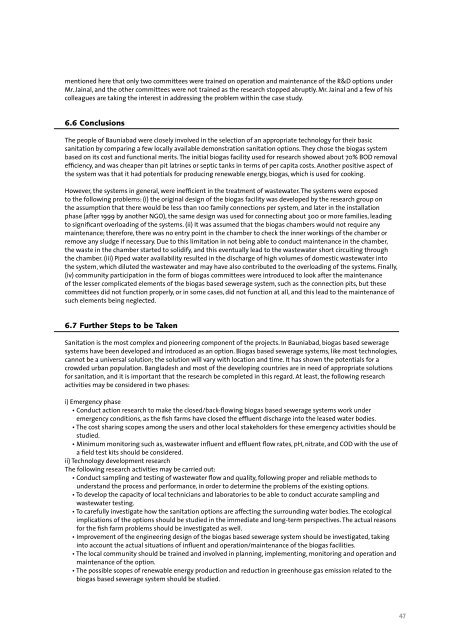Untitled - UNU-IAS - United Nations University
Untitled - UNU-IAS - United Nations University
Untitled - UNU-IAS - United Nations University
You also want an ePaper? Increase the reach of your titles
YUMPU automatically turns print PDFs into web optimized ePapers that Google loves.
mentioned here that only two committees were trained on operation and maintenance of the R&D options under<br />
Mr. Jainal, and the other committees were not trained as the research stopped abruptly. Mr. Jainal and a few of his<br />
colleagues are taking the interest in addressing the problem within the case study.<br />
6.6 Conclusions<br />
The people of Bauniabad were closely involved in the selection of an appropriate technology for their basic<br />
sanitation by comparing a few locally available demonstration sanitation options. They chose the biogas system<br />
based on its cost and functional merits. The initial biogas facility used for research showed about 70% BOD removal<br />
efficiency, and was cheaper than pit latrines or septic tanks in terms of per capita costs. Another positive aspect of<br />
the system was that it had potentials for producing renewable energy, biogas, which is used for cooking.<br />
However, the systems in general, were inefficient in the treatment of wastewater. The systems were exposed<br />
to the following problems: (i) the original design of the biogas facility was developed by the research group on<br />
the assumption that there would be less than 100 family connections per system, and later in the installation<br />
phase (after 1999 by another NGO), the same design was used for connecting about 300 or more families, leading<br />
to significant overloading of the systems. (ii) It was assumed that the biogas chambers would not require any<br />
maintenance; therefore, there was no entry point in the chamber to check the inner workings of the chamber or<br />
remove any sludge if necessary. Due to this limitation in not being able to conduct maintenance in the chamber,<br />
the waste in the chamber started to solidify, and this eventually lead to the wastewater short circuiting through<br />
the chamber. (iii) Piped water availability resulted in the discharge of high volumes of domestic wastewater into<br />
the system, which diluted the wastewater and may have also contributed to the overloading of the systems. Finally,<br />
(iv) community participation in the form of biogas committees were introduced to look after the maintenance<br />
of the lesser complicated elements of the biogas based sewerage system, such as the connection pits, but these<br />
committees did not function properly, or in some cases, did not function at all, and this lead to the maintenance of<br />
such elements being neglected.<br />
6.7 Further Steps to be Taken<br />
Sanitation is the most complex and pioneering component of the projects. In Bauniabad, biogas based sewerage<br />
systems have been developed and introduced as an option. Biogas based sewerage systems, like most technologies,<br />
cannot be a universal solution; the solution will vary with location and time. It has shown the potentials for a<br />
crowded urban population. Bangladesh and most of the developing countries are in need of appropriate solutions<br />
for sanitation, and it is important that the research be completed in this regard. At least, the following research<br />
activities may be considered in two phases:<br />
i) Emergency phase<br />
• Conduct action research to make the closed/back-flowing biogas based sewerage systems work under<br />
emergency conditions, as the fish farms have closed the effluent discharge into the leased water bodies.<br />
• The cost sharing scopes among the users and other local stakeholders for these emergency activities should be<br />
studied.<br />
• Minimum monitoring such as, wastewater influent and effluent flow rates, pH, nitrate, and COD with the use of<br />
a field test kits should be considered.<br />
ii) Technology development research<br />
The following research activities may be carried out:<br />
• Conduct sampling and testing of wastewater flow and quality, following proper and reliable methods to<br />
understand the process and performance, in order to determine the problems of the existing options.<br />
• To develop the capacity of local technicians and laboratories to be able to conduct accurate sampling and<br />
wastewater testing.<br />
• To carefully investigate how the sanitation options are affecting the surrounding water bodies. The ecological<br />
implications of the options should be studied in the immediate and long-term perspectives. The actual reasons<br />
for the fish farm problems should be investigated as well.<br />
• Improvement of the engineering design of the biogas based sewerage system should be investigated, taking<br />
into account the actual situations of influent and operation/maintenance of the biogas facilities.<br />
• The local community should be trained and involved in planning, implementing, monitoring and operation and<br />
maintenance of the option.<br />
• The possible scopes of renewable energy production and reduction in greenhouse gas emission related to the<br />
biogas based sewerage system should be studied.<br />
47
















